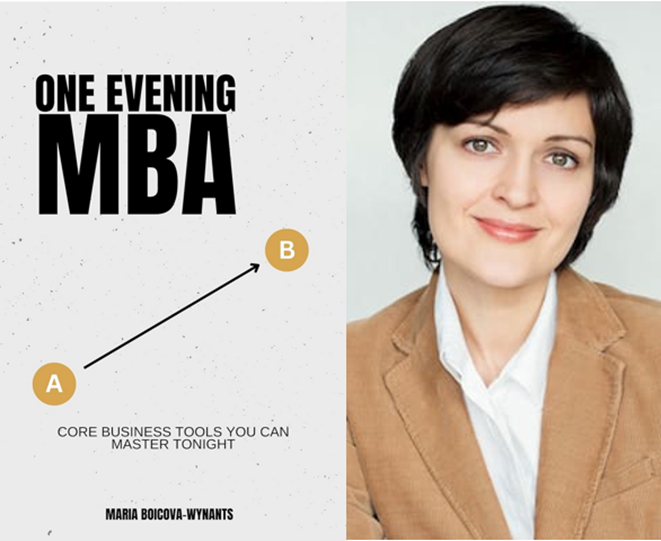From Strategy to Action in One Night: What Makes One Evening MBA a Must-Read for Busy Professionals
Business books often promise transformation but deliver either bloated theory or fleeting inspiration. Maria Boicova-Wynants’ One Evening MBA does neither. Instead, it serves as a crisp, no-nonsense roadmap for time-starved professionals who want an MBA’s practical edge without quitting their jobs or emptying their wallets.
This book is not a replacement for a full-fledged MBA — and Maria Boicova-Wynants says so herself — but what it does brilliantly is distil the core mental models, frameworks, and actions that shape sound business judgment. The result is something closer to an executive’s field manual than an academic tome.
Why a One-Evening MBA?
Boicova-Wynants opens by acknowledging what many busy managers already know but rarely say aloud: a classic MBA is often out of reach. Time is scarce, tuition is steep, and traditional business programs can drown professionals in exhaustive theory that rarely shows up in Monday’s meeting. What they need instead is what this book offers: lean, credible, practical guidance that moves the needle at work.
The promise here is simple but ambitious. By the final page, you’ll know how to frame strategy in clear economic terms, size markets with real data, speak the language of finance, lead teams with intention, evaluate digital risks realistically, and ground IP decisions firmly in strategy.
Thinking Like an Executive
The book’s first section tackles the most powerful habit any manager can build: the ability to pause, step back, and reframe problems before acting. This is not new advice, but the power lies in the structure Boicova-Wynants gives to it. She breaks strategic thinking into manageable chunks: clarifying purpose and vision, mapping the competitive landscape, positioning for advantage, and choosing a winning strategy.
Each sub-topic comes with tested questions, lively examples, and punchy action checklists. There’s a clear push to translate insight into action — not someday, but the next day at work.
For example, the chapter on clarifying purpose includes five sharp questions to help executives define why they exist and where they’re going. The advice on competitive mapping goes beyond textbook Porter’s Five Forces by adding a pragmatic ‘sixth force’: complementors — those players who can lift or sink your value proposition depending on how well you manage them.
Where the Book Shines: Making Strategy Tangible
Many business guides recycle strategic frameworks but fail to bridge the gap to real-life trade-offs. Here, the author’s two decades of advisory experience show up. Real cases — from craft coffee subscriptions to the dynamics of snack-bar shelf space — make abstract strategy tangible.
One story that sticks is about two founders with the same product idea. One races to market, the other pauses to craft a simple purpose, map competitors, pick a niche, and choose a realistic strategy. Eighteen months later, the latter is raising a Series A while the former is fire-selling leftover stock. The takeaway? Process and clarity beat hustle alone.
The “Choosing a Winning Strategy” chapter also stands out for its honesty about common traps. Overstated ambitions that masquerade as strategy, endless streams of data as an excuse to delay decisions, or pet projects posing as strategic options — Boicova-Wynants calls them out and suggests clear gut-checks to keep teams honest.
Business Models and Economics That Actually Add Up
Plenty of managers can talk strategy; far fewer can sketch how the money actually flows. The book’s second section dives into the practical side: building business models that make money, scale sensibly, and survive real-world messiness.
Readers learn to link revenue streams with their real cost drivers, pressure-test margins, calculate break-even points, and think through cash-flow timing — all essentials that many entrepreneurs and managers skip to their own peril.
Her section on pricing is especially refreshing. Instead of cost-plus guesswork or gut instinct, she pushes readers to tie pricing directly to the value created for customers. There’s solid advice on designing ‘price fences’ that keep premium buyers from drifting down to cheaper options without a fight, with examples from airlines to software. And she reminds readers that pricing is always a hypothesis to test, not a tattoo to wear forever.
Connecting Insight with Execution
The next parts move from strategy and economics to the nuts and bolts of reaching customers, scaling operations, and managing people. Boicova-Wynants devotes entire sections to market insight and customer journeys. She champions a customer-first mindset grounded in real behavior, not demographics or generic profiles.
In one striking example, a startup selling slim, reusable water bottles thought they were winning customers with “save the planet” messages. Customer interviews revealed that the real hook was the bottle’s convenience: it slipped neatly into a car’s cup holder and laptop bag. When they shifted messaging to “Hydrate on the go, no bulk,” sales doubled. This kind of insight-rich case study makes the book more than a static read — it becomes a troubleshooting guide.
Marketing and Growth Engines Without Fluff
Boicova-Wynants also doesn’t romanticize growth hacking or viral loops. Instead, she pairs customer insight with pragmatic advice on go-to-market paths, branding, and digital metrics that matter. She highlights loyalty loops — the habit-building systems that turn first-time users into repeat advocates. Her tone is brisk: test quickly, measure ruthlessly, and don’t drown in vanity metrics.
Operations, Finance, and People: The MBA Staples
The core MBA pillars round out the book. There are short, focused chapters on operations, supply chains, and the basics of financial fluency for decision-makers. Rather than teach balance-sheet theory, Boicova-Wynants sticks to what most busy leaders actually need: how to read the numbers well enough to make better calls.
The book’s approach to leadership and culture is equally lean. The tone is practical, acknowledging that corporate culture is not about slogans on walls but about aligning incentives, communication, and behaviours with the broader strategy. Her chapter on leading people is peppered with simple but effective prompts: what behaviours get rewarded, who really holds informal power, and how feedback loops tighten or unravel trust.
Innovation, Digital, and Data Without the Hype
A particularly timely strength is how the book tackles innovation and digital transformation. In an age when every company claims to be a tech company, Boicova-Wynants is refreshingly cautious about shiny objects. She urges managers to weigh digital bets with the same strategic rigor they’d apply to any other investment — balancing hype with sober risk assessment.
Responsibility, Sustainability, and Global Thinking
One of the final sections covers ethics, sustainability, and stakeholders. Here the book broadens its lens to include the responsibilities modern businesses shoulder: balancing profit with impact, weighing trade-offs in supply chains, and facing the reality that today’s stakeholders — employees, regulators, communities — care about more than quarterly returns.
Boicova-Wynants argues persuasively that embedding ethics and sustainability in everyday choices is not idealistic but pragmatic. Stakeholder trust is fragile, and reputational hits in today’s connected world can cost more than most leaders imagine.
The IP Thread: An Unexpected Bonus
Finally, and fittingly given the author’s background, there’s a bonus chapter weaving intellectual property throughout the MBA essentials. Boicova-Wynants demonstrates how IP is not just a legal afterthought but a strategic tool for defending unique positions, partnerships, and market value. For anyone who’s ever treated IP as just paperwork, this chapter is a brisk wake-up call.
Who Should Read This Book?
One Evening MBA is not a book for those looking for deep case studies, grand economic theories, or the warm fuzzies of business storytelling. Its tone is brisk, its structure modular, and its intent laser-focused: give busy professionals a toolkit they can actually use tomorrow.
It’s especially suited for mid-level managers ready to step up, early-stage founders who need a crash course in executive basics, or seasoned specialists (like IP lawyers or engineers) who suddenly find themselves in business leadership roles.
A Few Small Caveats
This practicality-first approach naturally leaves out the messy debates and serendipitous discovery that happen in a full MBA classroom. Some readers may wish for more depth in topics like organizational change or deeper dives into international markets. But to expect this would miss the point: the book is a field map, not a deep mine.
Another small trade-off is the density of checklists and frameworks. For action-oriented readers, they are gold. For the more reflective reader, the pace may feel breathless at times.
The Bottom Line
Maria Boicova-Wynants has delivered exactly what she promised: a concise, credible, and action-ready MBA-in-a-book for people who have no time for fluff. The voice is crisp, the tools tested, and the stories real enough to stick.
If your bookshelf groans under weighty MBA texts gathering dust while you wrestle with next quarter’s targets, pull this slim volume down instead. Keep it at arm’s reach, mark it up, and revisit the frameworks as real work throws new challenges your way.
For many (IP) managers, this may be the only MBA they ever take — and judging by its focus and practicality, that may well be enough.



